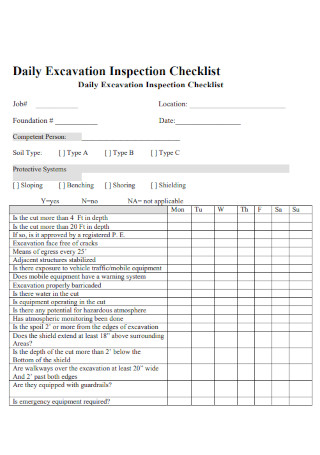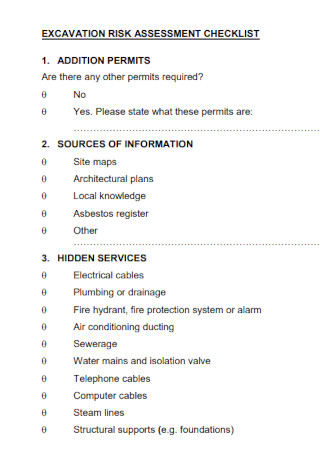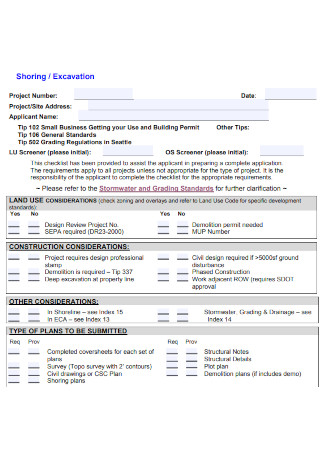13+ SAMPLE Excavation Checklist
-

Simple Excavation Checklist
download now -

Sample Excavation Checklist
download now -

Daily Worksite Checklist for Trenching Excavation Sites
download now -

Excavation & Trenching Safety Checklist
download now -

Daily Excavation Inspection Checklist
download now -

Daily Excavation Checklist
download now -

Excavation Checklist Report
download now -

Excavation Safety Checklist
download now -

Trench Excavation Checklist
download now -

Pre Excavation Checklist
download now -

Excavation Risk Assesment checklist
download now -

Trench Log Excavation Checklist
download now -

Shoring Excavation Checklist
download now -

Excavation Permit Application Checklist
download now
FREE Excavation Checklist s to Download
13+ SAMPLE Excavation Checklist
What Is an Excavation Checklist?
Benefits of Site Safety
Tips for Always Preserving Workplace Health and Safety
How to Write a Construction Safety Plan
FAQs
What is checklist preparation?
What is a checklist in construction?
What is the purpose of excavation?
What Is an Excavation Checklist?
Excavations are used in construction to remove things like soil, rocks, or other debris. This is done with tools, high-powered machinery, and explosives. It is a dangerous job, so excavation inspection is essential. Site safety management comes up with precautions to ensure accidents don’t happen. These safety measures provide that all equipment, workers, and the site are safe enough to work with. All of these things need to be on the excavation checklist. Researchers have found that at least 108 thousand workers die annually, about 30% of all workplace deaths. Several industrialized countries have found construction workers are 3–4 times more likely to die than other workers.
Benefits of Site Safety
No matter what type of work you do, whether it’s office work or physical labor, there may be risks where you work. If you don’t know how to safely negotiate with these possible dangers, you could get hurt or have an accident that makes it hard for you to work. By learning more about safety practices at your workplace, you can protect yourself and your coworkers from harm and keep everyone in a safe environment. Here are a few ways that employees and the company can both benefit from following health and safety rules:
Tips for Always Preserving Workplace Health and Safety
Employees and employers must ensure that their employees comprehend the significance of health and safety on the job. As a supervisor or team leader, for instance, providing optimal workplace safety standards can help you create a better, safer environment for employees and clients to engage. Whether for yourself, your subordinates, or your coworkers, it is always advantageous to seek out additional safety measures for the workplace. Here are some guidelines for achieving and maintaining optimal health and safety conditions at work:
1. Use all prescribed safety equipment
It is essential to constantly wear the proper safety equipment on the job, as these regulations are in place to protect you. The type of equipment may vary based on the workplace’s nature and the work performed. It might be reflective clothing, safety boots for hard labor, or something as basic as a face mask for desk work.
2. Report any potential health risks or dangerous circumstances
Typically, the corporation is responsible for handling all health and safety requirements and infrastructure. You can notify your supervisor or HR department if you observe a deficiency in these health and safety infrastructures, a health danger, or other unsafe circumstances requiring prompt care. This is especially crucial if you discover a problem you cannot remedy immediately.
3. Utilize all business equipment and machinery correctly.
An employee’s improper use of equipment, tools, and machinery is a leading cause of workplace accidents and injuries. By preventing injuries and lowering the likelihood of accidents, the proper use of these things can keep everyone safe. The company must keep all equipment and machinery clean and in optimal condition and train staff on how to use them effectively. However, you may assist in reducing health and safety hazards by following these tools and equipment instructions.
4. Regular health checks
Being fit and maintaining a healthy physique can be vital, as health and productivity are frequently correlated. When your body is not performing effectively, your productivity may suffer. Some businesses may be responsible for conducting frequent health checks on their employees, such as blood and drug tests or verifying that staff is mentally and physically fit to work. In addition, employers may provide health insurance for their employees, regardless of whether they perform office work or physical labor. According to research, frequent health examinations can detect early warning signals of health problems. Early detection of the issues increases your chances of receiving effective therapy. Numerous variables, including your age, health, family history, and lifestyle choices, influence how frequently you need checkups
5. Maintain vigilance for new safety methods.
Typically, businesses are responsible for developing new workplace safety policies, standards, and equipment. They ensure that their personnel is aware of these procedures, instruct them in the proper use of techniques, routinely monitor their compliance with these standards, and discipline those who violate them. As an employee, you should ensure that you comprehend how to operate all suggested equipment, ask pertinent questions, and adhere to safety requirements to assist in a safe and functional workplace.
6. Use mechanical aids
Wheelbarrows, forklifts, and conveyor belts can assist in lifting and transporting heavy equipment in the workplace if you have an industrial labor position. Use this help instead of attempting to move big objects by yourself. Using these tools instead of conducting the operation helps limit the danger of injuries, ensuring that no one is injured.
How to Write a Construction Safety Plan
Regardless of how skillfully a construction job is performed, the ability to complete a project safely is what matters most. With a comprehensive construction safety plan in place, your team can protect everyone on the job site and ensure the client that your company can mitigate risks and respond to crises. Writing a safety plan requires planning, but once completed, your team will have a sound plan in the event of an emergency. Adherence to an outline or template expedites the process. The following items are typically included in safety plans:
1. Allow Flexibility And Adaptability
The flexibility and adaptability of safety plans should allow teams to utilize them across numerous projects. Since construction is a dynamic business with considerable variability in terms of dangers and working circumstances, it is even more critical to have an adaptable safety plan for every type of project. For instance, a general safety plan typically includes information on who to notify in the event of an accident. In contrast, a site-specific safety strategy customizes and individualizes safety practices for each construction project.
2. Require Personal Protective Equipment and Emergency Contact
Include a list of each employee’s protective equipment (PPE) in your safety plan to demonstrate to clients that your organization is devoted to the safety of all employees. Examples of personal protective equipment include hard helmets, sunglasses, face masks, and earmuffs. Each employee is accountable for and well-trained in adequately using and maintaining their safety equipment. In addition, a well-designed construction safety plan guarantees that all on-site staff can respond quickly and effectively to any incident. Designating one or more emergency contact persons in the safety plan is one of the best strategies to shorten emergency response times. Internal and external contacts should be included on this list of emergency contacts. In addition to site supervisors and property managers, emergency support services such as the fire department, paramedics, and police must also be present.
3. Specific Rules for Construction Sites
For example, smoking in places that aren’t meant for it is a typical safety risk on construction sites. Even though the Occupational Safety and Health Administration doesn’t have any rules about smoking areas on construction sites, it should still be every employer’s top priority to make sure the workplace is safe.
4. Clarify the Roles of Each Employee
Every employee contributes significantly to the effectiveness of a safety plan. Before beginning a project, all construction workers and subcontractors should thoroughly understand their job descriptions and responsibilities. Employers should include in a safety plan the activities each employee should take in the case of an emergency and ensure that each employee is aware of their responsibilities.
5. Establish Protocols To Mitigate Risk
One of the primary functions of a safety plan is to outline the company’s procedures for risk management and workplace safety. Employers should incorporate operating instructions for heavy machinery and excavation safety measures in their plans to prevent accidents. When threats become a reality, construction projects can be delayed, and workers may also sustain serious accidents. To avert these catastrophes, ensure safety standards are implemented on all sites.
6. Consider the Conditions of the Weather
Most building projects are outdoors, so you must consider weather conditions when developing your design. As the weather cannot be controlled or influenced, ensure that each construction site has a strategy for extreme weather conditions, ranging from extreme cold to excessive heat. Start by assessing the site-specific risks associated with a severe weather event. Then, tailor your safety strategy to your region’s types of extreme weather.
FAQs
What is checklist preparation?
A preparation checklist enables you to assess whether your preparations for a specific event are enough. Using the lists, you can determine that the essential resources are available in sufficient quantities. According to research, following a checklist results in less anxiety and fewer drills. You can devote more concentration and mental energy to creative endeavors by conquering all laborious, repetitive jobs. You will think more clearly if you have more free time and fewer tasks.
What is a checklist in construction?
Checklists for construction projects include specific information on activities and phases. Construction checklists can precisely classify specific things, supplies, equipment, jobs, etc. Checklists for construction reduce complex tasks into essential, executable components. Ninety percent of the construction industry still uses paper inspection checklists and has been hesitant to accept new creative technology. Although lists are one of the most effective tools for a project manager, paper versions need more visibility.
What is the purpose of excavation?
In construction, excavation is used to build foundations, reservoirs, and highways. Trenching, digging, dredging, and site development are a few techniques employed in excavation. Each of these procedures necessitates specialized methods, equipment, and tools to be effective.
Excavation is a procedure integral to the construction of every structure. This facilitates the construction of significant facilities to their utmost capacity by granting greater control over the job site. However, this is one of the most dangerous work environments and occupations. It is a highly hazardous and accident-prone environment to operate in. Even though it is unavoidable, corporations continue to enforce construction safety and health to protect their employees and the surrounding community. Therefore, utilizing a checklist for routine checks serves as a constant reminder to take precautions at all times.
